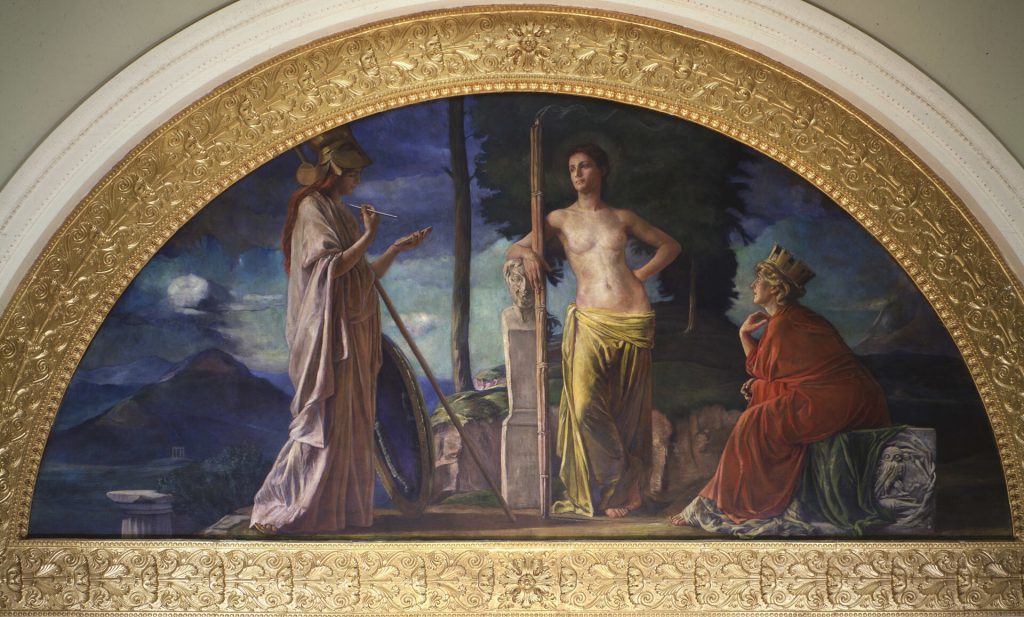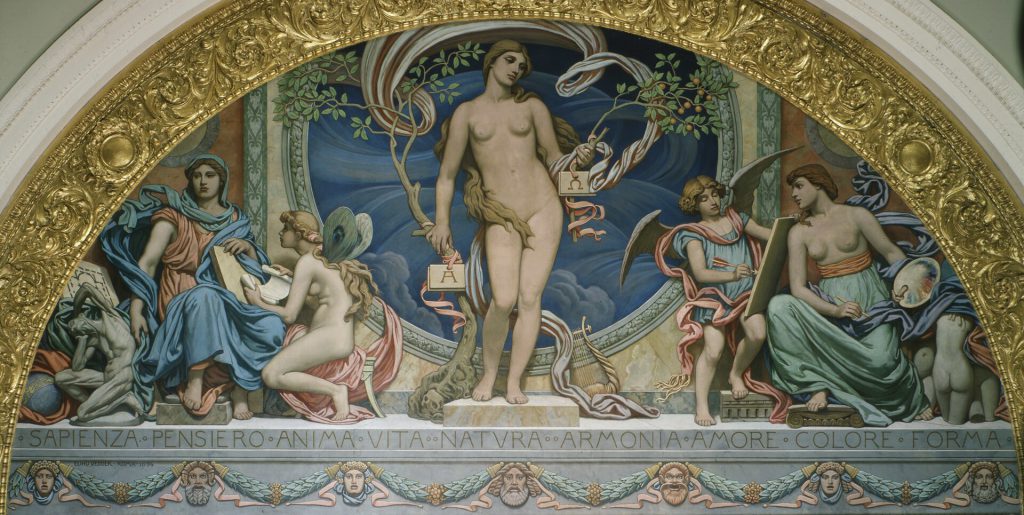
Gift of the Misses Harriet Sarah and Mary Sophia Walker
1893.38The rotunda sculpture gallery of the Walker Art Building is completed by four mural paintings that filled the large lunettes above each gallery entrance. For these murals, the Walker sisters and architect Charles McKim commissioned four of the country’s leading painters: Elihu Vedder (1836–1923), John La Farge (1835–1910), Abbott Thayer (1849–1921), and Kenyon Cox (1856–1919). Each had travelled extensively and trained in Europe where the cultural output of the Renaissance and Greek and Roman antiquity was on display. These travels show in their choice of subject matter: allegorical treatments of the four major cities then understood as foundational in the evolution of (Western) art history: Athens (La Farge), Rome (Vedder), Florence (Thayer), and Venice (Cox). The privileged position of Greece and Rome in this hierarchy is signaled not only in their placement in the building but also in their assignment to the two most senior and prominent artists, La Farge and Vedder respectively.
Elihu Vedder’s mural, the first to be commissioned, is also the most universal and the first work encountered upon entering the Museum. While ostensibly depicting Rome, the work figures an allegory of “The Art Idea.” The painting, it has been argued, encapsulates “the philosophical premise of the entire American Renaissance.” The visual language of the piece is steeped in reference to the ancient world, with its allegorical figures and erotes. The personification of “Nature”—the source of all art—stands at the center of the composition, her pose lifted from classical statuary and her figure bracketed by the Greek letters alpha and omega she holds, the first and last letters of the Greek alphabet signaling the all-encompassing nature of the mural. The groupings to the left and right could be renaissance sculptures or paintings in their carefully and symmetrically balanced design; they form the essential building blocks of knowledge and art, respectively. Embedded in these groupings are also references to the work of Michelangelo and Raphael, central figures in the art history of Renaissance-era Rome. It is fitting that Vedder’s mural is also the one most steeped in classical reference and refined classicizing style; of the four artists, Vedder had the longest residence in Rome and the most exposure to its antiquities.
Of the remaining murals, each demonstrates qualities of the American Renaissance taste and the appreciation of ancient and Renaissance art history to varying degrees. In John La Farge’s Athens— situated opposite Vedder’s Rome—the goddess Athena, patron of Athens and associated with the arts and wisdom, draws a personified Nature from life while a personification of the city of Athens looks on. While the figures of Athens are all more immediately ancient in their guise and dress, La Farge painted them in a style that is more naturalistic and less classicizing and formal than Vedder’s figures. Their poses are only loosely drawn from ancient (or Renaissance) models; Athena’s garb is easily recognized from the repertoire of Greek and Roman statuary of the goddess, while Nature’s contrapposto pose and semi nudity vaguely recalls depictions of Venus, particularly the Venus de Milo in the Louvre. The Tyche of Antioch, an ancient Greek sculpture, may similarly serve as a model for the seated personification of the city. The environs render the scene specific to Athens and include a Doric capital, a herm, and a relief carving of an owl—symbol of the city and companion to Athena. In Kenyon Cox’s Venice, the enthroned Renaissance personification of the city is accompanied on her left and right by Mercury, the god of commerce, and a vaguely classical personification of Painting, respectively. Only Abbott Thayer’s Florence lacks obvious reference to the Greco-Roman past; instead it is based in part on Renaissance altarpieces depicting kneeling donors and features Renaissance shields with heraldic crests below.
Collector
Donors of the Walker Art Building as well as a significant collection of art and antiquities, Mary Sophia Walker (1839–1904) and Harriet Sarah Walker (1844–1898) were among the most significant benefactors in the development of the art collection at Bowdoin.



